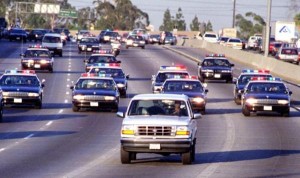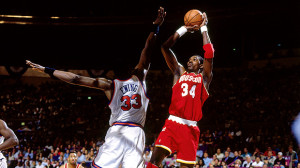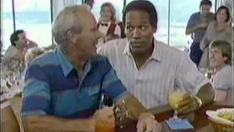20 Years Ago: A Sports Day Like No Other

The O.J. Simpson White Bronco chase on June 17, 1994 captivated a nation though it didn’t break any speed records.
This past Thursday sports broadcasters spent a great deal of time discussing what a great sports day it was with the start of the U.S. Open Golf Tournament, World Cup Soccer Championships and the fourth game of the NBA Finals. Certainly an exciting day for sports fans and broadcasters alike, but nothing like a day whose twentieth anniversary we celebrate this week.
The primary sports elements on June 17, 1994 were basically the same as twenty years later, but the story lines in some cases were a bit more compelling. Then, of course, what makes that particular day unlike any other sports day was an un-scripted and un-expected event that transcended sports and captured the attention of the entire country.
Even though the United States wasn’t playing until the next day, June 17th was the most important day to that point in U.S. Soccer history with the opening ceremonies of the first World Cup ever held in the United States. President Bill Clinton, Diana Ross, Opera Winfrey and Daryl Hall were among those who participated in the festivities at Soldier Field in Chicago.
While many hoped the World Cup would usher a new era of interest for soccer in America, half a country away in Oakmont, Pennsylvania, the second round of the U.S. Golf Open included the end of an era for an American sports treasure.
Playing in the U.S. Open for the final time, Pennsylvania native Arnold Palmer said goodbye to the national stage on that Friday afternoon by shooting a final round 81 to finish 16 stokes over par. The 1960 U.S. Open Champion had played his first Open at Oakmont in 1953 and on that Friday afternoon 41 years later had an emotional conclusion to his magical career.
The irony of Palmer being a major storyline on this interesting sports day would become evident later in the evening.
The third major sporting event happening that day was the fifth game of the NBA Finals at Madison Square Garden in New York City. The Houston Rockets and New York Knicks had split the first four games and the country was excited to see the fifth battle between towering centers Hakeem Olajuwon and Patrick Ewing.
Just those three big events promised an exciting buffet for sports fans, but eventually all those events would be overshadowed by an event that in itself was not a sports story, but had a sports overtone because the primary figure was one of the best known sports figures of the day.
O.J. Simpson had first gained national attention as a Heisman Trophy winning tailback for the USC Trojans in the 1960s. He then went on prominence as a record-setting back for the Buffalo Bills. In 1973 he became the first player in NFL history to rush for more than 2,000 yards in a season and he remains the only player to do so in a 14-game season.
After retiring from the NFL following the 1979 season and being inducted to the Pro Football Hall of Fame in 1985, Simpson became even better known for his television commercials (most notably in Hertz Rental Car Commercials that sometimes also included Arnold Palmer), NBC Sports Television Broadcasting and in motion pictures like the Naked Gun series.
It is easy through the lens of time to forget just how popular Simpson was in 1994. He was one of the first African American athletes who seemed to easily maneuver in the corporate world and was arguably one of the widest known Americans despite having been retired for 14 years.
That is one reason why the events that reached a crescendo on June 17, 1994 were so shocking and bizarre.
It started with word on June 13th of the death of Simpson’s ex-wife, Nicole Brown Simpson, and a friend, Ronald Goldman.
The early coverage of the murders did not include mention of Simpson as a suspect and there was video footage of him during the week at his former wife’s funeral.
Then word started to leak that Simpson was indeed a suspect and eventually that he would be charged with the murders and turn himself in on that Friday.
Even given that surprising development, it is doubtful that the situation would have ever reached the national obsession that it became had Simpson quietly turned himself in as originally planned.
Interestingly enough, my family was at another sporting event, a Baltimore Orioles-Minnesota Twins baseball game at Camden Yards, that evening.
It was while in the stadium shop about 5:30 EDT that I and many others standing around the shop saw an image that was totally unexpected and quickly signaled that something big was happening on the west coast.
On the screen was a Los Angeles Police Officer announcing that Simpson had not turned himself in as expected, that they didn’t know where he was and that they were actively searching for “Mr. Simpson”. You could hear the gasps among those in the press conference hearing those words and I remember chatting with others in the shop about how crazy it was that Simpson was being charged with murder and that he was possibly running.
The Los Angeles District Attorney was especially blunt saying that Simpson was “a fugitive of justice.”
We went on to the game and really didn’t worry about it anymore for the next few hours.
In the interim while we were enjoying a game the Orioles would win 9-2 with Ben McDonald earning a complete game victory, the L.A. Police Department were locating Simpson to start what might have been the slowest car chase in police history.
Turns out that Simpson’s lifelong friend and former Buffalo Bills teammate A.C. Cowling was driving Simpson around town in a White Ford Bronco and the former football star was in the back of the vehicle with a gun to his head and considering whether to end his life or turn himself in.

While most of America was focused on a white Bronco, Patrick Ewing and Hakeem Olajuwon were focused on winning an NBA title.
When we got back to our hotel room after the baseball game we had planned to watch game five of the NBA Finals. Instead, we ended up focusing more on the turmoil in Los Angeles than the game in New York.
Once Simpson and the white Bronco were located, the pursuit became an odd media event that seemed to captivate the nation.
In the era before Twitter, Facebook, Smart Phones and really even the proliferation of the internet, the primary sources for information were the three network TV news networks and CNN.
Of the four, NBC, which ironically was the network for which Simpson at the time served as a football broadcast analyst, had the toughest decision. Because they were showing the NBA Finals on live television, they had to decide how much of the “chase” to show.
Ultimately, they switched back and forth a few times and also at times showed the game in a box with most of screen dedicated to the Simpson chase.
Once Simpson and Cowling had been located, the big question seemed to be whether O.J. would turn himself in or if the entire world was going to be witness to the suicide of one of the most iconic athletes of the era.
At that point, I don’t really remember there being much discussion of whether he was guilty or innocent. I think to many the fact he was a fugitive (there was reports later that he had a bag full of cash along with his passport) and was considering killing himself was all but an admission of guilt.
I also remember at that time expecting there to be a very quick resolution.
When O.J. did finally return to his house and eventually turned himself in, you almost expected there to be an announcement that he had confessed and that the matter was settled.
However, as anyone who got sucked into the live TV drama that followed for the next year and a half, the aftermath was anything but swift.
Instead of confessing, Simpson quickly “lawyered up” and eventually his team started blasting holes into what originally seemed to be a pretty straight forward prosecution case.
Both the pre-trial and later the trial were broadcast live on national television and it seemed that you couldn’t walk into a business or restaurant that had a television that wasn’t watching the O.J. trial.
It wasn’t until October 3, 1995 that the case reached some level of conclusion with a not-guilty verdict. However, in 1997 a civil trial determined that Simpson was responsible for the murders and awarded the families more than $40 million in compensation.
It was this judgment that indirectly led to Simpson eventually landing in jail, where he remains today. In 2008, Simpson was sentenced to 33 years in prison for leading an armed invasion in Las Vegas designed at recovering some of his sports memorabilia that had been seized as part of the civil judgment.
There have been many exciting and interesting sports days, but it seems highly unlikely that we will ever see another day where sports, life, news and reality converge in quite as interesting a manner as June 17, 1994.











